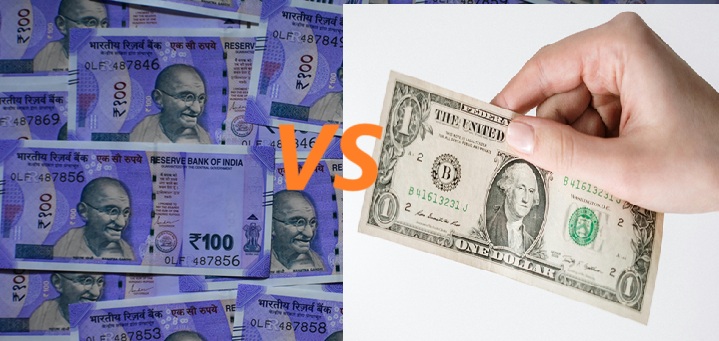Indian Rupee Vs American Dollar
In recent months, the Indian rupee has experienced significant depreciation against the US dollar, sparking debates about the factors driving this decline and its broader implications for the Indian economy. To understand this phenomenon, it is essential to explore the historical relationship between the Indian rupee and the US dollar, analyze recent causes of rupee depreciation, and consider global movements such as de-dollarization.

A Brief History of the Indian Rupee vs. the Dollar
The Indian rupee’s journey has been marked by a series of changes since its independence in 1947. Initially pegged to the British pound and indirectly to the US dollar, the rupee transitioned to a market-determined exchange rate system in the 1990s after economic liberalization.
In 1947, 1 Indian rupee was equivalent to 1 US dollar. This parity existed due to a fixed exchange rate system and India’s limited engagement in global trade. However, a series of economic challenges, such as balance-of-payment crises and inflation, led to the rupee’s devaluation. By the 1960s, the exchange rate hovered around 7.5 rupees per dollar. The 1991 economic crisis forced India to undertake substantial structural reforms, including a shift to a floating exchange rate system. Since then, the rupee’s value has been influenced by market dynamics, including trade deficits, foreign investment flows, and global economic conditions.
Fast forward to 2024, the Indian rupee has fallen to around 83-85 against the US dollar, a reflection of various global and domestic pressures.

Why is the Rupee Falling Against the Dollar Recently?
The current decline of the Indian rupee can be attributed to several intertwined factors:
Strong US Dollar
The US dollar index, which measures the dollar’s strength against a basket of major currencies, has remained robust due to aggressive interest rate hikes by the US Federal Reserve. Higher interest rates in the US attract foreign investments, leading to capital outflows from emerging markets like India.
Trade Deficits
India’s trade deficit, the gap between imports and exports, has widened due to rising crude oil prices and increased import bills. Since oil is traded in dollars, higher oil prices increase the demand for dollars, putting pressure on the rupee.
Geopolitical Tensions
The ongoing geopolitical tensions, including the Russia-Ukraine war, have disrupted global supply chains and led to increased volatility in commodity prices. These factors have further weakened emerging market currencies, including the rupee.
Decline in Foreign Direct Investment (FDI)
While India continues to attract foreign investments, there has been a relative decline in FDI inflows due to global economic uncertainties. Lower capital inflows reduce the demand for the rupee, contributing to its depreciation.
Domestic Inflation
Rising inflation in India has eroded purchasing power and deterred foreign investors. Inflationary pressures also make Indian exports less competitive in global markets, compounding the trade deficit.
Outflow of Foreign Portfolio Investments (FPIs)
Higher yields in US bonds have prompted foreign investors to withdraw from Indian equities and bonds, leading to further depreciation of the rupee.
Implications of a Weak Rupee

While a depreciating rupee poses several challenges, it also offers some opportunities:
Challenges:
Higher Import Costs: Essential imports like crude oil, machinery, and electronics become costlier, leading to higher inflation.
Impact on Foreign Debt: India’s external debt servicing burden increases as the rupee weakens.
Pressure on Current Account Deficit (CAD): A weaker rupee widens the CAD, affecting India’s macroeconomic stability.
Opportunities:
Boost to Exports: A weaker rupee makes Indian goods and services cheaper in global markets, potentially boosting exports.
Increased Remittances: Non-resident Indians (NRIs) benefit from favorable exchange rates, leading to higher remittance inflows.
The Concept of De-dollarization
De-dollarization refers to the process of reducing reliance on the US dollar in global trade and financial transactions. Over the decades, the US dollar has maintained its position as the world’s reserve currency, accounting for the majority of international trade settlements and foreign exchange reserves. However, recent global shifts indicate a growing interest in diversifying away from the dollar.

Why is De-dollarization Gaining Momentum?
Geopolitical Shifts: Countries like Russia and China are leading the de-dollarization movement to reduce dependence on the US-dominated financial system, especially in response to economic sanctions.
Diversification of Reserves: Central banks in emerging markets are increasing their gold reserves and diversifying into other currencies like the euro, yuan, and yen.
Bilateral Agreements: Nations are increasingly signing bilateral trade agreements to settle transactions in their local currencies.
India’s Role in De-dollarization
India has also taken steps toward de-dollarization. Initiatives include:
Trade in Rupees: The Reserve Bank of India (RBI) has encouraged trade settlement in rupees with partner countries, particularly for oil imports from Russia.
Internationalization of the Rupee: Efforts are underway to promote the rupee as a global trading currency.
Gold Reserves: India has increased its gold reserves as a hedge against dollar volatility.
Significance of De-dollarization
Reduced Vulnerability to Dollar Volatility
De-dollarization can shield economies from exchange rate fluctuations and reduce dependency on the US monetary policy.
Enhanced Economic Sovereignty
By diversifying away from the dollar, countries can mitigate the risk of economic sanctions and maintain greater control over their monetary policies.
Cost Savings in Trade
Trading in local currencies eliminates conversion costs and can strengthen bilateral trade relationships.
Promotion of Regional Currencies
De-dollarization paves the way for regional currencies to play a more prominent role in global trade.
Balancing De-dollarization with Reality
While the move toward de-dollarization offers significant benefits, there are challenges to consider:
Dominance of the Dollar: The dollar’s liquidity, stability, and acceptance worldwide make it challenging to replace.
Infrastructure Needs: Transitioning to alternative systems requires significant investments in financial infrastructure.
Trust in Regional Currencies: Building trust in regional currencies takes time, especially in volatile economies.
The Road Ahead for the Indian Rupee
India’s approach to addressing rupee depreciation must involve both short-term measures and long-term strategies:
Short-Term Measures
RBI Interventions: The central bank can use foreign exchange reserves to stabilize the rupee and curb excessive volatility.
Attracting Investments: Offering incentives to attract FDI and FPIs can bolster the rupee.
Long-Term Strategies
Reducing Trade Deficits: Enhancing export competitiveness and diversifying import sources can address trade imbalances.
Promoting Rupee Internationalization: Encouraging more countries to trade in rupees can reduce reliance on the dollar.
Strengthening Economic Fundamentals: Focusing on fiscal discipline, infrastructure development, and ease of doing business will enhance India’s global economic standing.
Conclusion
The falling rupee against the US dollar is a multifaceted issue driven by global and domestic factors. While the immediate impacts pose challenges, strategic measures can mitigate long-term risks. The concept of de-dollarization adds an interesting dimension to this narrative, offering a pathway to reducing dependence on the dollar and enhancing economic resilience. However, a balanced and pragmatic approach is essential to ensure sustainable growth and stability.
Disclaimer
This blog is for informational purposes only and does not constitute financial or investment advice. The analysis and opinions expressed herein are based on publicly available data and should not be construed as definitive or exhaustive. Readers are advised to consult with financial experts or conduct their research before making economic or financial decisions. The author and publisher disclaim any liability for any losses or damages arising from the use of this information.


Recent Comments